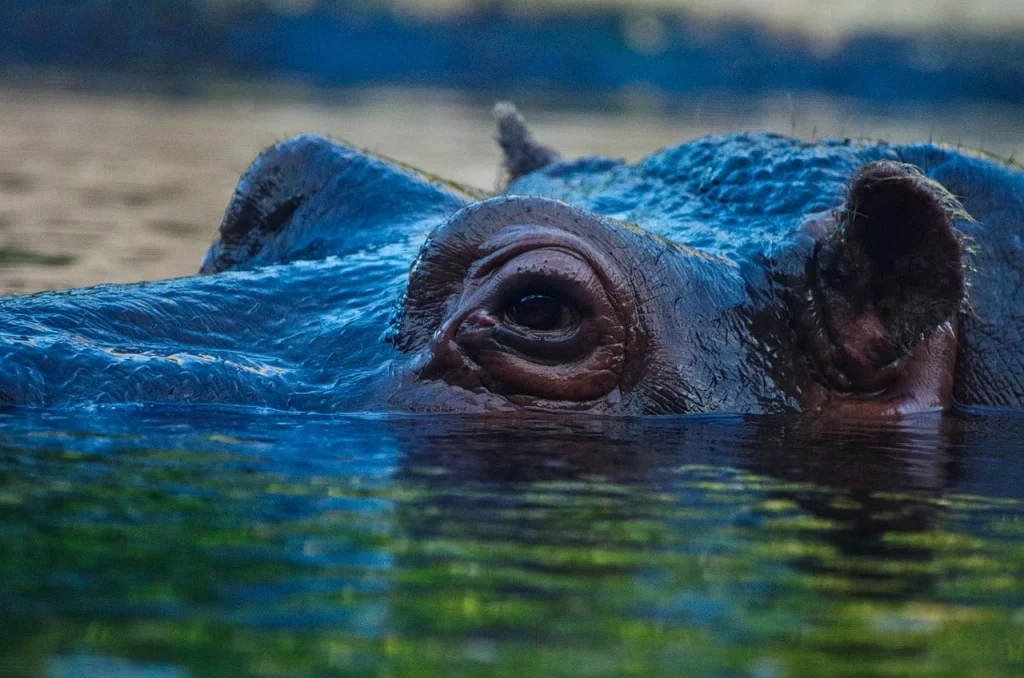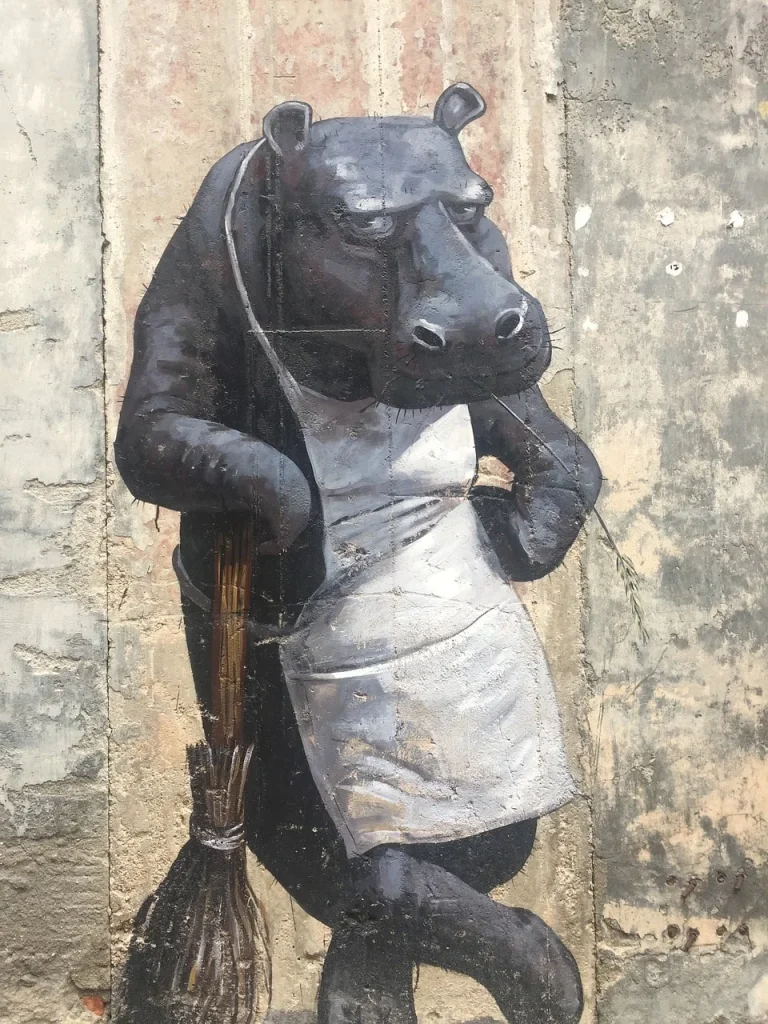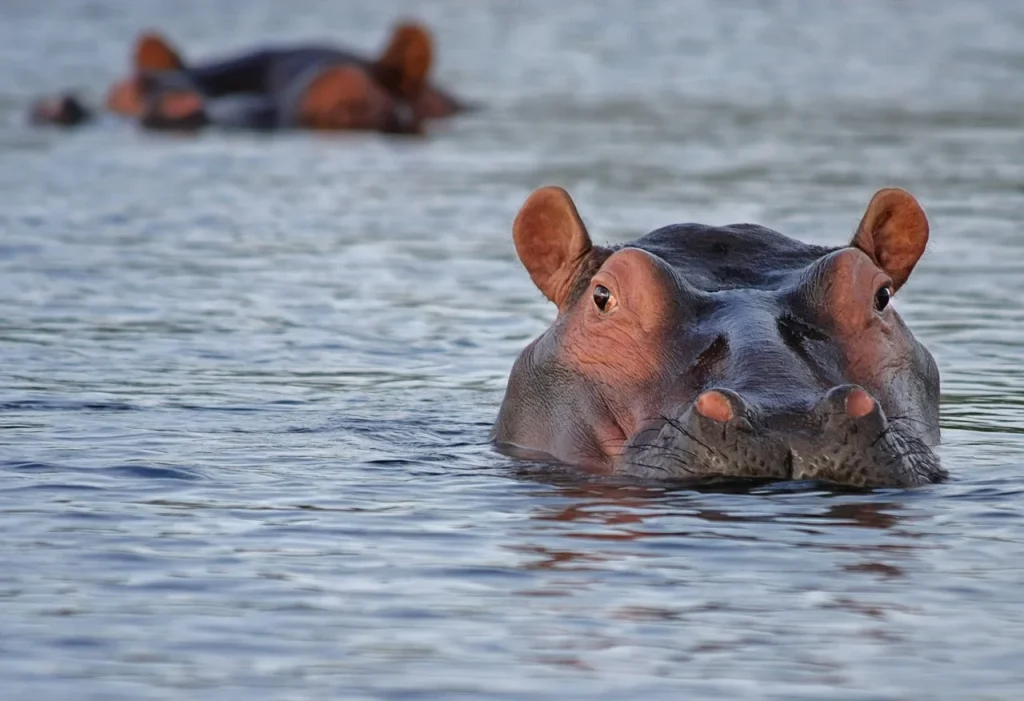Did you know that hippos spend most of their day soaking in water to keep cool under the hot sun? It’s true! These giant mammals, known for their massive size and impressive yawns, are full of surprises. From their enormous mouths to their surprising speed, hippos are not just big—they’re fascinating!
But let’s not make them blush; they’re already quite heavy! So, are you ready to dive deep into the world of hippos and learn some jaw-dropping facts about these water-loving creatures? Let’s start.
The hippo’s hide is bulletproof, but it can’t save it from human greed.
Wangari Maathai
Hippo Facts
Get ready to explore the amazing world of hippos! Pay close attention to the facts, as you’ll need them to succeed in the quiz at the article’s end.
- Despite their bulky appearance, these animals can run up to 30 kilometers per hour on land.
- Their skin secretes a natural sunscreen, which appears red and helps protect their skin from the sun’s harmful UV rays.
- These creatures have teeth that can grow up to 50 centimeters in length, mainly used for combat rather than feeding.
- Their closest living relatives are dolphins and whales, rather than other land mammals.
- Contrary to popular belief, they don’t swim. Instead, they move by pushing off from the riverbed or other surfaces.
- Baby hippos are born underwater and must swim to the surface to take their first breath.
- They have a huge mouth, capable of opening to nearly 150 degrees.
- Their jaws are capable of exerting an impressive 1800 pounds of force per square inch.
- Known to be highly territorial in water, their aggressiveness is one of the highest among mammals.
- They consume primarily grass, needing about 40 kilograms of it each night.
- These mammals mark their territory by spinning their tails while defecating to spread their waste over a larger area.
- Despite living in water bodies, they cannot float. They sink and use this ability to walk or run underwater.
- They have a multi-chambered stomach for fermentation of plant material, but they are not true ruminants.

- Their lifespan can reach up to 50 years in the wild and longer in captivity.
- Their specific gravity allows them to stay submerged underwater for up to five minutes without floating to the surface.
- During mating season, a single male can fiercely guard up to ten females within his territory.
- Their large teeth and tusks are not used for chewing food but rather for fighting.
- In ancient Egypt, they were both revered and feared, often featured in art and considered a symbol of protection and fertility.
- They are capable of producing unique vocalizations, some of which can be heard up to two kilometers away.
- Despite their bulk, they can easily maneuver in water, where they spend most of their time to stay cool.
- Unusually for a large mammal, their skin is only about two inches thick.
- National Geographic reports that their aggressive behavior makes them one of the most dangerous animals in Africa.
- Interestingly, their name means ‘river horse’ in ancient Greek.
- Their presence in a river can significantly impact the environment, affecting both water quality and the types of plant growth.
- They are known to host a unique type of symbiotic algae on their skin, which may contribute to the natural sunscreen effect.
- Unlike most other large mammals, they give birth in water and not on land.
- They play a critical role in aquatic ecosystems by controlling vegetation and creating pathways used by other animals.
- In the wild, their most common cause of death is fighting with other individuals of their species.

- They can store two days’ worth of grass in their stomachs and go without eating while staying in water all day.
- Their ability to open their mouths so wide is due to a unique joint anatomic adaptation in their skull.
- Even though they are mostly nocturnal feeders, they can spend up to 16 hours a day in the water resting.
- Despite their bulky size, they are surprisingly stealthy when submerged.
- Zoos often struggle to replicate the natural diet and environment, leading to innovative conservation and care techniques.
- They have very few natural predators due to their size and aggression, with humans and large crocodiles being the exception.
- Young calves are often vulnerable to predation by crocodiles, lions, and hyenas, despite their mother’s vigilant protection.
- They have specialized lungs that allow them to control their buoyancy and stay submerged for extended periods.
- Their ears and nostrils close to form a watertight seal when they submerge.
- A group of them is known as a pod, which can consist of up to 30 individuals, though larger groups are not uncommon.

- Research suggests that their large size and aquatic lifestyle may have evolved as a form of predator deterrence.
- They can consume up to 80 pounds of grass in a single night.
- Infants are often seen riding on their mother’s back while swimming in the water to avoid predators.
- Their ability to sweat a red, oily liquid has led to myths about them sweating blood, but it’s purely a protective biofluid.
- During the dry season, they can engage in long-distance nightly treks of several kilometers to find sufficient grasslands.
- Despite their herbivorous diet, their aggressive nature leads to more human fatalities each year than lions.
- Their blood contains natural antibiotics, which help heal wounds and prevent infection, essential for their survival.
- Historical records suggest that they were once common along the Nile River but now are mostly found in protected areas due to habitat loss.
- They often engage in mouth-to-mouth battles that can be fatal, demonstrating their fiercely competitive nature.
- Research has shown that their large canines and incisors continuously grow throughout their lives.
- Even though primarily vegetarian, these giants can occasionally display carnivorous behavior, particularly when nutrients are scarce, consuming carcasses when opportunity arises.
- Their sweat acts as an efficient cooling system. This unique secretion not only provides sun protection but also regulates their body temperature in the intense African heat.
Hippo Myths

Now that we’ve explored the facts, let’s dive into the myths. It’s time to separate what’s true from what’s purely fictional about hippos.
- Hippos are slow because of their size
Despite their large size, they are remarkably fast and agile. Speeds of up to 30 kilometers per hour can be reached by them on land, and they are also adept swimmers. This speed allows them to be quite dangerous, especially if surprised or threatened. - Hippos eat large amounts of meat
Contrary to some popular beliefs, they are primarily herbivores. Grass is primarily consumed by them, and they feed at dusk. Although they have been observed scavenging on occasion, plant material makes up the bulk of their diet. - Hippos sweat blood
The reddish secretion seen on hippos is not blood. Instead, a natural sunscreen is produced by their skin, which helps to protect them from the sun’s harmful rays. This secretion is known as “blood sweat” due to its color. - Hippos are docile and friendly
Although they may appear lethargic or friendly, they are actually one of the most aggressive animals in the world. Their territory and young are fiercely protected by them, and they have been known to attack boats and humans without provocation. - Hippos live in saltwater environments
They are found in freshwater rivers and lakes across sub-Saharan Africa. Saltwater habitats are not typically suitable for them, as fresh water is required for their daily activities, such as feeding and cooling off.
No products found.
Hippo Quotes

We continue our journey with some quotes about hippos. You can always share yours in the comments section so I can add them to the list.
No animal is half as vile as a frightened man, or half as loving as a hippo.
Terry Pratchett
Terry Pratchett, renowned for his wit and wisdom in literature, highlights the surprisingly affectionate nature of hippos compared to human behavior under fear.
A hippopotamus does not bite, it swallows.
Pliny the Elder
Pliny the Elder, a Roman author and natural philosopher, intriguingly describes the hippo’s unique feeding behavior, emphasizing its large mouth and swallowing capabilities.
The only beast which surpasses the hippo in size is the elephant.
Aristotle
Aristotle, the ancient Greek philosopher, noted for his observations on nature, compares the hippo’s massive size to that of an elephant, underscoring its grandeur.
Hippos are the very definition of ‘hidden danger’ beneath the water’s surface.
Jane Goodall
Jane Goodall, a primatologist and anthropologist, provides insight into the deceptive calmness of hippos in water, pointing out the potential danger they represent.
The hippopotamus is proof that some creatures are born to stand out and not blend in.
Steve Irwin
Steve Irwin, known as the Crocodile Hunter, celebrates the unique and conspicuous nature of the hippo, a creature that naturally draws attention due to its distinct characteristics.
Hippo FAQ

As we approach the FAQ section, remember that this is your last chance to get some knowledge before the quiz. Read these carefully to ensure you’re fully prepared!
- Can hippos jump?
No, they cannot jump. Due to their large size and heavy bodies, which can weigh up to 4,500 pounds, hippos are not built for jumping. They are mostly aquatic and are well-adapted to moving in water rather than leaping. - Are hippos omnivores?
They are primarily herbivores. They mainly eat grasses and occasionally fallen fruit. Their digestive systems are adapted to a plant-based diet, and they typically graze on land during the cooler evening hours. - Will hippos eat meat?
While they are mainly herbivores, there have been rare instances where hippos have been observed eating meat, but this behavior is not typical. It’s believed that such behavior could be due to nutrient deficiencies or environmental stresses. - Are hippos endangered?
Yes, they are considered vulnerable to extinction. Their populations are threatened by habitat loss due to agricultural expansion and are also affected by illegal hunting for their ivory canine teeth and meat. - What is the bite force of a hippo?
They have one of the strongest bite forces among mammals, estimated to be around 1,800 pounds per square inch. This powerful bite is a defense mechanism that protects them against threats and helps them in fighting off rivals.
No products found.
Hippo Trivia

Welcome to our hippo-sized quiz! If you don’t manage to get any questions right, don’t worry—no hippos will be crashing through your door. But we might just have to enroll you in Hippo 101!
Hippo Merch
If you are a true fan of hippos, then you definitely need to check out our merchandise. You can find T-shirts, hoodies, mugs, and tote bags for your favorite designs. Feel free to check out all the other designs in our shop.
Conclusion
To wrap up, hippos are not just another animal; they are key players in their ecosystems with complex behaviors and physical capabilities that astonish and educate us.
Whether it’s their ability to navigate both land and water with ease, their vital role in maintaining the African river systems, or their unexpected speed, hippos continue to capture our imagination and respect. Till next time, stay curious and explore more. Cheers.
2 Sources Used For This Article

